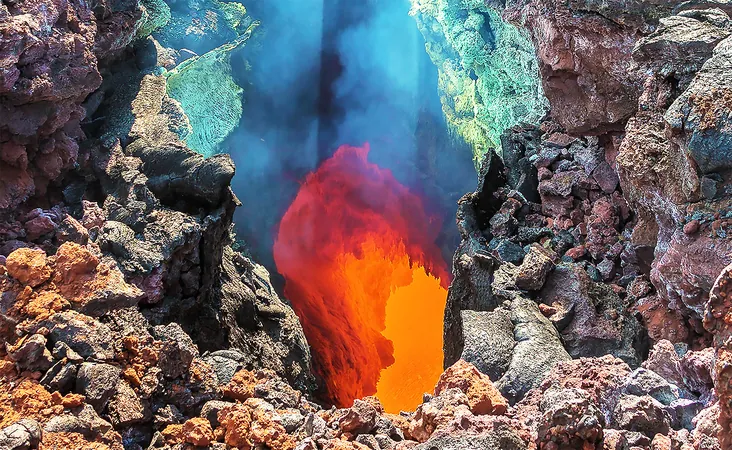
Shocking Discovery: North America’s Ancient Crust is Dripping Rock into the Earth's Mantle!
2025-04-04
Author: Wei Ling
Beneath the solid surface of North America lies an astonishing revelation: scientists have found that the continent's stable crust is slowly dripping away in blobs of rock!
This groundbreaking discovery offers a glimpse into a rare geological phenomenon known as "cratonic thinning," which is currently taking place under the Midwestern United States.
Led by a team at the University of Texas at Austin, the study has been spearheaded by researcher Junlin Hua, who previously conducted his work as a postdoctoral fellow at the Jackson School of Geosciences. "We made the observation that there could be something beneath the craton," said Hua. "Luckily, we also got the new idea about what drives this thinning."
What is causing this unusual phenomenon?
Cratons are ancient, stable rock foundations that make up the heart of continents, some of which have remained unchanged for billions of years. Despite their resilience, these geological formations can undergo transformations. Cratonic thinning involves the loss of parts of the structure, particularly its densest root layers.
This process, although rare, has been previously recorded in other regions, such as the North China Craton; however, what sets this discovery apart is its current occurrence, allowing scientists to witness real-time geological changes.
Understanding the Dynamics Beneath Our Feet
Despite its intriguing nature, researchers assure that there is no immediate risk to the surface landscape from this dripping rock, which is happening at an incredibly slow pace. Mantle dynamics, a key factor in tectonic plate evolution, act over a span of millions of years, ensuring that the surface remains stable for the foreseeable future.
The study attributes these geological shifts to the ancient Farallon Plate, an oceanic plate that began subducting beneath North America around 200 million years ago. Its remnants, located approximately 600 kilometers below the surface, continue to influence the continent's geological dynamics.
Co-author Thorsten Becker, a professor at the Jackson School’s Department of Earth and Planetary Sciences, emphasized the importance of this research: "It helps us understand how continents are formed, broken apart, and recycled back into the Earth."
High-Tech Insights into Earth's Inner Workings
This groundbreaking research arises from an extended seismic modeling project, using full-waveform seismic tomography to gain detailed insights into the Earth's interior. This advanced technique analyzes how seismic waves navigate through different materials to create a clearer picture of geological structures.
Utilizing data from the EarthScope project, the high-resolution model has allowed scientists to visualize these dripping rock formations for the first time and connect them back to the lingering influence of the Farallon Plate. This phenomenon affects the mantle's material flow, which may not only diminish the craton's stability but also release volatile substances that contribute to its degradation.
While the dripping is most pronounced beneath the Midwest, it is noticeable that the entire North American craton, which extends across much of the United States and Canada, exhibits signs of thinning. "A very broad range is experiencing some thinning," noted Hua.
Why This Discovery Matters!
This revelation reshapes our understanding of how continents evolve throughout geological time. It underscores that even the most ancient structures beneath us are susceptible to dynamic and powerful forces. As scientists continue to enhance seismic imaging technologies and refine their models of Earth's inner workings, we may soon uncover more about the transformative processes that shape our planet from deep beneath the surface.
Stay tuned for further updates on this captivating exploration into our Earth's geological mysteries! Research findings were published in the prestigious journal *Nature Geoscience*.




 Brasil (PT)
Brasil (PT)
 Canada (EN)
Canada (EN)
 Chile (ES)
Chile (ES)
 Česko (CS)
Česko (CS)
 대한민국 (KO)
대한민국 (KO)
 España (ES)
España (ES)
 France (FR)
France (FR)
 Hong Kong (EN)
Hong Kong (EN)
 Italia (IT)
Italia (IT)
 日本 (JA)
日本 (JA)
 Magyarország (HU)
Magyarország (HU)
 Norge (NO)
Norge (NO)
 Polska (PL)
Polska (PL)
 Schweiz (DE)
Schweiz (DE)
 Singapore (EN)
Singapore (EN)
 Sverige (SV)
Sverige (SV)
 Suomi (FI)
Suomi (FI)
 Türkiye (TR)
Türkiye (TR)
 الإمارات العربية المتحدة (AR)
الإمارات العربية المتحدة (AR)